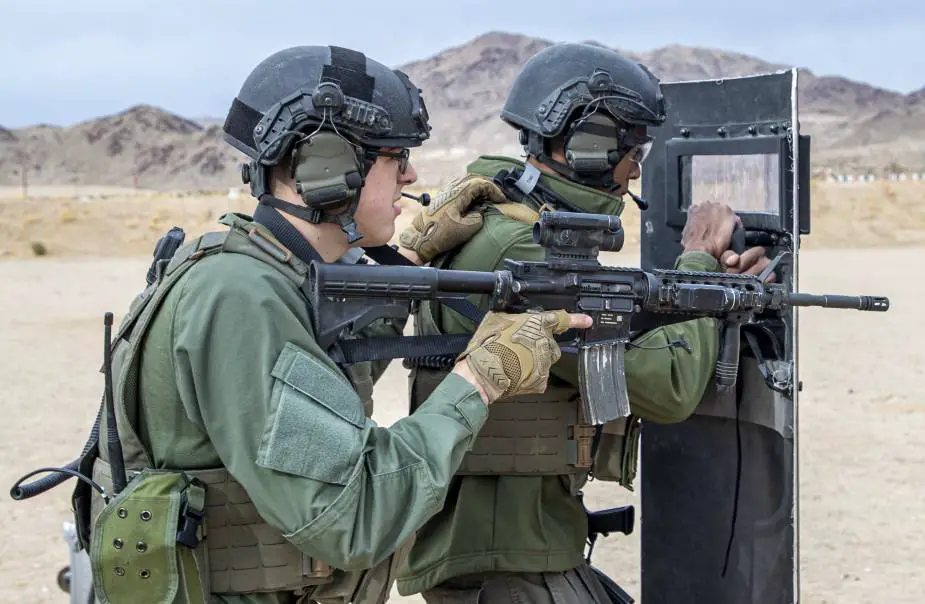Breaking news
Combat center SRT develops its US Marines in fire movement and breaching techniques.
U.S. Marines with the Special Reaction Team, Provost Marshall’s Office, Marine Corps Air Ground Combat Center, Twentynine Palms, California, executed training on fire, movement and breaching techniques at the base Dec. 11, 2020. Lance Cpl. Joshua Sechser, Marine Corps Air Ground Combat Center Twentynine Palms, reports.
Follow Army Recognition on Google News at this link

U.S. Marine Corps Lance Cpl. Edgar Wooten (left), basic entryman, and U.S. Marine Corps Sgt. Marcus Edwards (right), team commander, Special Reaction Team, Provost Marshall’s Office, Marine Air Ground Task Force Training Command, practice coordinated movement techniques during an SRT familiarization range at Marine Corps Air Ground Combat Center, Twentynine Palms, California, Dec. 11, 2020. (Picture source: U.S. Marine Corps/by Lance Cpl. Joshua Sechser)
SRT Marines are military police officers trained in responding to hostage situations, active shooters and barricaded suspects. Sgt. Marcus L. Edwards, SRT commander, said : “Our primary mission as the Special Reaction Team requires us to handle all the sorts of calls too erratic for your average military police officer. PMO is always a first response to emergencies. We act as a secondary reaction force in any incidents of suspected terrorism, active shooters or in the case that a suspect is barricaded in place.”
Edwards, a native of Columbia, South Carolina, has been with the SRT for over two years. He stated that the SRT acts as a quick reaction force for incidents on MCAGCC and its housing areas.
Each Marine Corps installation has a supporting Provost Marshall’s Office comprised of military police officers and Department of Defense civilian employees. The SRT is comprised of anywhere from 7 to 14 of those military police officers. “We have Marines trained with various breaching techniques such as: acetylene torches, explosive charges, battering rams, and saws; one main guy who acts as our shield Marine; and the entry Marines in our stack on an emergency call,” Edwards said.
The SRT also includes a marksman observer who provides an overhead perspective during missions. “Our average team is a pretty small, tight-knit group,” Edwards said. “The size can vary as Marines reach their end of active service and move to different duty stations. To maintain our numbers we hold a semi-annual screening process.”
SRT supervisors evaluate volunteers for screening from the base Provost Marshall’s Office on their physical fitness and proficiency on basic Marine tasks in order to ensure excellence in their team. Applicants are also screened during several interview boards to ensure the potential team mates have the personality traits essential to comprehensive team work.
“Our selection is pretty tough,” said Lance Cpl. Jesse Rastetter, SRT shield Marine. “We need to run a first-class physical fitness test and combat fitness test and have an expert qualification score with our rifle and pistol. We go over some of the basics of room clearing and methods of entry into a room or building and do a lot of hard PT.”
Rastetter, a Sebring, Ohio native, has been receiving on the job training with the SRT for nearly two months : “At this point I’m just waiting to head out to Ft. Leonard Wood for our basic entry course”. The course is a two-week training curriculum that enables Marines to receive a secondary military occupational specialty as a basic entry Marine and serve in full capacity with the SRT, he said. “My Marines and I are always excited to get out and train,” Edwards said. “We try to get out to the range or conduct some sort of realistic training at least once a week.”
SRT is constantly developing and training for the evolution of possible situations and scenarios. They stay ready to react to any scenario that falls within their mission set.



















